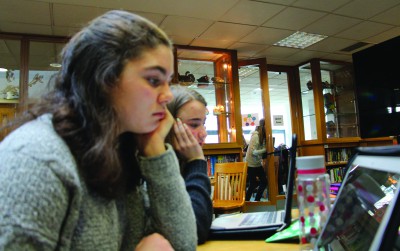
Starting after Winter Break, Grade 8 students have been required to take part in the Your Choice project, a project which isn’t the most helpful addition to schoolwork for students. This project asks students to choose a topic they feel passionately about, and create a group project with other students who have your same interest. The project can be focused around a passion, a skill, a problem students wish they could fix, etc, and requires students to spend a large amount of time on it over the year.
Between January and May, two advisory periods per week are dedicated to working on the Your Choice project. This means that any time spent bonding with advisory peers is taken up working on the project, so students do not get nearly as much time in advisory as they could have.
Advisory is a time to bond with peers who you wouldn’t see as often during the day, and also helps students get their work organised and ready for the classes ahead.
Because advisory is only a 30 minute period every day, and some weeks is even replaced by assembly, advisory time is very limited. By taking away even more advisory time, and putting in the Your Choice project, there is barely any time for students to get prepared for the school day or to talk with their advisory.
Along with the fact that advisory time is very limited due to the project, fifty percent of the students surveyed in a poll conducted by The Scroll believe they haven’t learned anything new from the project. “It’s a waste of time,” said eighth grader Noor Zalt. “In advisory, we can at least have discussions and plan out our week [but in the Your Choice project, we don’t].” Other students polled believed the project was “pointless” and “unhelpful.”
Although advisory time is only half an hour, the time slot gives just enough time for students to talk with their peers and advisor, and get ready for the day. It does not, however, provide the Your Choice project with enough time, because the amount of time given only allows for minimal work to be done on the project. Many students have projects which involve meeting with people, gathering other things from home, and doing work which cannot be done at school.
Because advisory is so short, students do not have enough time to do these things or get a sufficient amount of work done on their projects. A time slot of thirty minutes is not enough for students to do what they need to do for their project, so this often results in students just talking and sitting around, rather than getting much done. “We could be doing more productive things,” said eighth grader Catherine Bennett. The lack of productivity in students’ projects is clearly dependent on how much time students have to work on it, and without having more time, there aren’t many productive things for students to do.
Many students have ideas on how to improve this project, such as having it once a week, making it optional or even shortening the time we spend on it. One great way to help this project become more successful would be giving students the option to choose whether or not they would like to meet to work on the project or not. “I wish we would only meet when necessary,” eighth grader Gabriel Hajjar said.
The Your Choice project is an interesting new project for students, but the way it is currently formatted makes it difficult to enjoy advisory time or get any work done. If the format of the problem was changed, students’ time could be spent doing more of the things they enjoy, or care about, which is the primary focus of Your Choice.
